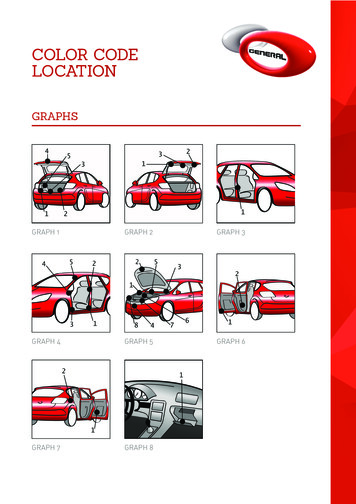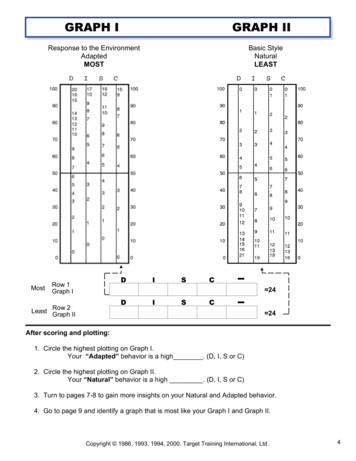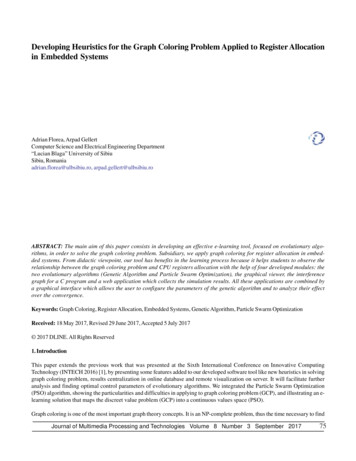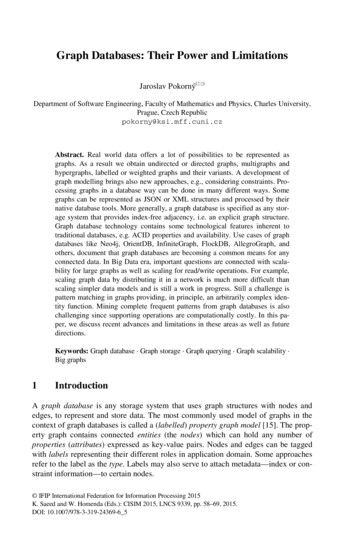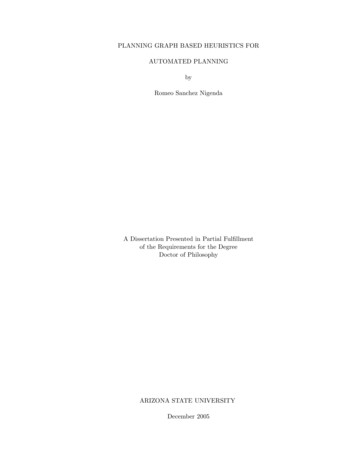
Transcription
PLANNING GRAPH BASED HEURISTICS FORAUTOMATED PLANNINGbyRomeo Sanchez NigendaA Dissertation Presented in Partial Fulfillmentof the Requirements for the DegreeDoctor of PhilosophyARIZONA STATE UNIVERSITYDecember 2005
PLANNING GRAPH BASED HEURISTICS FORAUTOMATED PLANNINGbyRomeo Sanchez Nigendahas been approvedJuly 2005APPROVED:, ChairSupervisory CommitteeACCEPTED:Department ChairDean, Division of Graduate Studies
ABSTRACTThe main concern in automated planning is to construct a sequence of actions thatachieves an objective given an initial situation of the world. Planning is hard; even themost restrictive case of automated planning, called classical planning, is PSPACE-completein general. Factors affecting planning complexity are large search spaces, problem decomposition and complex action and goal interactions.One of the most straightforward algorithms employed to solve classical planningproblems is state-space search. In this algorithm, each state is represented through a nodein a graph, and each arc in the graph corresponds to a state transition carried out by theexecution of an action from the planning domain. A plan on this representation correspondsto a path in the graph that links the initial state of the problem to the goal state. The cruxof controlling the search involves providing a heuristic function that can estimate the relativegoodness of the states. However, extracting heuristic functions that are informative, as wellas cost effective, remains a challenging problem. Things get complicated by the fact thatsubgoals comprising a state could have complex interactions. The specific contributions ofthis work are:An underlying framework based on planning graphs that provides a rich sourcefor extracting distance-based heuristics for disjunctive planning and regression state-spaceplanning.Extensions to the heuristic framework to support the generation of parallel plans instate-space search. The approach introduced generates parallel plans online using planninggraph heuristics, and plan compression techniques; andThe application of state-space planning to cost-based over-subscription planningproblems. This work extends planning graph heuristics to take into account real executioniii
costs of actions and goal utilities, using mutex analysis to solve problems where goals havecomplex interactions.Beyond the context of planner efficiency and impressive results, this research can bebest viewed as an important step towards the generation of heuristic metrics that are informative as well as cost effective not only for state-space search but also for any other planningframework. This work demonstrates that state-space planning is a viable alternative forsolving planning problems that originally were excluded for taking into consideration giventheir combinatorial complexity.iv
To my family:My dear wife Claudia, and little Romeo who are my inspiration.v
ACKNOWLEDGMENTSFirst, I would like to express my full gratitude to my advisor, Prof. SubbaraoKambhampati. I would really like to thank him not only for his unconditional supportduring my graduate studies, but also for his continuous encouragement and understandingthat help me overcome many problems in my personal life. I really appreciate his vastknowledge of the field, enthusiasm, and invaluable criticism, which were strong guidance fordeveloping high quality work.I also would like to thank the other members of my committee, Prof. Chitta Baral,Prof. Huan Liu, and Dr. Jeremy Frank for the assistance they provided at all levels of myeducation and research. My special thanks to Dr. Frank of NASA Ames Research Centerfor giving many insightful comments on my dissertation, and for taking time from his busyschedule to serve as an external committee member.A special thanks goes to my dear friends in the research team, YOCHAN, whosecomments, support, and advice over the past 5 years have enriched my graduate educationexperience. In particular, Ullas Nambiar, Menkes van den Briel, BinhMinh Do, ThomasHernandez, Xuanlong Nguyen, Blipav Srivastava, Terry Zimmerman, Dan Bryce, and Sreelakshmi Vaddi.On a personal level, I would like to thank my parents who have always supportedme with their love during my education. Last but not least, all my love to my wife Claudiaand my little Romeo, who have resigned to almost everything in order to be with me duringeach instant of my life.vi
TABLE OF CONTENTSPageLIST OF TABLES . . . . . . . . . . . . . . . . . . . . . . . . . . . . . . . . . . . . .xLIST OF FIGURES . . . . . . . . . . . . . . . . . . . . . . . . . . . . . . . . . . . .xiCHAPTER 1 Introduction . . . . . . . . . . . . . . . . . . . . . . . . . . . . . . . .11.1. Specific Research Contributions . . . . . . . . . . . . . . . . . . . . . . . . .51.2. Thesis Organization . . . . . . . . . . . . . . . . . . . . . . . . . . . . . . .6CHAPTER 2 Background on Planning and State-space Search . . . . . . . . . . .82.1. The Classical Planning Problem. . . . . . . . . . . . . . . . . . . . . . . .102.2. Plan Representation . . . . . . . . . . . . . . . . . . . . . . . . . . . . . . .122.2.1. Binary State-variable Model . . . . . . . . . . . . . . . . . . . . . . .132.3. Heuristic State-space Plan Synthesis Algorithms . . . . . . . . . . . . . . .172.3.1. Forward-search . . . . . . . . . . . . . . . . . . . . . . . . . . . . . .192.3.2. Backward-search . . . . . . . . . . . . . . . . . . . . . . . . . . . . .202.4. Heuristic Support for State-space Planning . . . . . . . . . . . . . . . . . .23CHAPTER 3 Planning Graphs as a Basis for Deriving Heuristics . . . . . . . . . .263.1. The Graphplan Algorithm . . . . . . . . . . . . . . . . . . . . . . . . . . . .273.2. Introducing the Notion of Heuristics and their Use in Graphplan . . . . . .313.2.1. Distance-based Heuristics for Graphplan . . . . . . . . . . . . . . . .323.3. Evaluating the Effectiveness of Level-based Heuristics in Graphplan . . . .363.4. AltAlt: Extending Planning Graph Based Heuristics to State-space Search .37vii
Page3.5. Extracting Effective Heuristics from the Planning Graph . . . . . . . . . . .393.6. Controlling the Cost of Computing the Heuristics . . . . . . . . . . . . . . .473.7. Limiting the Branching Factor of the Search Using Planning Graphs . . . .483.8. Empirical Evaluation of AltAlt . . . . . . . . . . . . . . . . . . . . . . . . .50CHAPTER 4 Generating Parallel Plans Online with State-space Search . . . . . .564.1. Preliminaries: Alternative Approaches and the Role of Post-processing . . .594.2. Introducing AltAltp , its Architecture and Heuristics . . . . . . . . . . . . .604.3. Selecting and Fattening a Search Branch in AltAltp . . . . . . . . . . . . . .624.4. Compressing Partial Plans to Improve Parallelism . . . . . . . . . . . . . .694.5. Results from Parallel Planning . . . . . . . . . . . . . . . . . . . . . . . . .714.5.1. Comparing AltAltp with Competing Approaches . . . . . . . . . . .724.5.2. Comparison to Post-Processing Approaches . . . . . . . . . . . . . .754.5.3. Ablation Studies . . . . . . . . . . . . . . . . . . . . . . . . . . . . .78CHAPTER 5 Planning Graph Based Heuristics for Partial Satisfaction (Oversubscription) Planning . . . . . . . . . . . . . . . . . . . . . . . . . . . . . . . . .825.1. Problem Definition and Complexity . . . . . . . . . . . . . . . . . . . . . . .845.2. Background: AltAltps Cost-based Heuristic Search and Goal Selection . . .885.2.1. Propagating Cost as the Basis for Computing Heuristics . . . . . . .895.2.2. Cost-sensitive Heuristics . . . . . . . . . . . . . . . . . . . . . . . . .915.3. AltAltps Goal Set Selection Algorithm . . . . . . . . . . . . . . . . . . . . .935.4. AltWlt: Extending AltAltps to Handle Complex Goal Scenarios . . . . . . .96viii
Page5.4.1. Goal Set Selection with Multiple Goal Groups. . . . . . . . . . . .995.4.2. Penalty Costs Through Mutex Analysis . . . . . . . . . . . . . . . .1025.5. Empirical Evaluation . . . . . . . . . . . . . . . . . . . . . . . . . . . . . . .108CHAPTER 6 Related Work . . . . . . . . . . . . . . . . . . . . . . . . . . . . . . .1126.1. Heuristic State-space Search and Disjunctive Planning . . . . . . . . . . . .1136.2. State-space Parallel Planning and Heuristics . . . . . . . . . . . . . . . . . .1166.3. Heuristic Approaches to Over-subscription Planning . . . . . . . . . . . . .119CHAPTER 7 Concluding Remarks . . . . . . . . . . . . . . . . . . . . . . . . . . .1227.1. Future Work . . . . . . . . . . . . . . . . . . . . . . . . . . . . . . . . . . .123REFERENCES . . . . . . . . . . . . . . . . . . . . . . . . . . . . . . . . . . . . . . .126APPENDIX A PSP DOMAIN DESCRIPTIONS AND COST-UTILITY PROBLEMS138A.1. Rover Domain . . . . . . . . . . . . . . . . . . . . . . . . . . . . . . . . . . .139A.2. Rover Problem . . . . . . . . . . . . . . . . . . . . . . . . . . . . . . . . . .142A.2.1. Problem 11 . . . . . . . . . . . . . . . . . . . . . . . . . . . . . . . .142A.2.2. Problem 11 Cost File and Graphical Representation . . . . . . . . .152ix
LIST OF TABLESTable1.PageEffectiveness of level heuristic in solution-bearing planning graphs. The columnstitled Level GP, Mop GP and Sum GP differ in the way they order actions supportinga proposition. Mop GP considers the cost of an action to be the maximum cost ofany if its preconditions. Sum GP considers the cost as the sum of the costs ofthe preconditions and Level GP considers the cost to be the index of the level inthe planning graph where the preconditions of the action first occur and are notpair-wise mutex. . . . . . . . . . . . . . . . . . . . . . . . . . . . . . . . . . .2.35Comparing the performance of AltAlt with STAN, a state-of-the-art Graphplan system, and HSP-r, a state-of-the-art heuristic state search planner.x.50
LIST OF FIGURESFigurePage1.Planning substrates. . . . . . . . . . . . . . . . . . . . . . . . . . . . . . .112.Rover planning problem . . . . . . . . . . . . . . . . . . . . . . . . . . . . .143.Partial rover state-space . . . . . . . . . . . . . . . . . . . . . . . . . . . . .184.Forward-search algorithm . . . . . . . . . . . . . . . . . . . . . . . . . . . .195.Execution of partial plan found by Forward-search . . . . . . . . . . . . . .216.Backward-search algorithm . . . . . . . . . . . . . . . . . . . . . . . . . . .237.The Rover planning graph example. To avoid clutter, we do not show theno-ops and Mutexes. . . . . . . . . . . . . . . . . . . . . . . . . . . . . . . .298.Architecture of AltAlt . . . . . . . . . . . . . . . . . . . . . . . . . . . . . .389.Results in Blocks World and Logistics from AIPS-00 . . . . . . . . . . . . .5210.Results on trading heuristic quality for cost by extracting heuristics frompartial planning graphs. . . . . . . . . . . . . . . . . . . . . . . . . . . . . .5311.Architecture of AltAltp . . . . . . . . . . . . . . . . . . . . . . . . . . . . . .6012.AltAltp notation . . . . . . . . . . . . . . . . . . . . . . . . . . . . . . . . .6013.Node expansion procedure . . . . . . . . . . . . . . . . . . . . . . . . . . . .6314.After the regression of a state, we can identify the P ivot and the related setof pairwise independent actions. . . . . . . . . . . . . . . . . . . . . . . . . .15.64Spar is the result of incrementally fattening the P ivot branch with the pairwise independent actions in O . . . . . . . . . . . . . . . . . . . . . . . . . .6416.PushUp procedure . . . . . . . . . . . . . . . . . . . . . . . . . . . . . . . .6717.Rearranging of the partial plan . . . . . . . . . . . . . . . . . . . . . . . . .68xi
FigurePage18.Performance on Logistics (AIPS-00) . . . . . . . . . . . . . . . . . . . . . .7319.Performance on ZenoTravel (AIPS-02) . . . . . . . . . . . . . . . . . . . . .7620.AltAlt and Post-Processing vs. AltAltp (Zenotravel domain) . . . . . . . . .7721.Analyzing the effect of the PushUp procedure on the Logistics domain . . .7922.Plots showing the utility of using parallel planning graphs in computing theheuristics, and characterizing the overhead incurred by AltAltp in serial domains. . . . . . . . . . . . . . . . . . . . . . . . . . . . . . . . . . . . . . . .23.80Hierarchical overview of several types of complete and partial satisfactionplanning problems. . . . . . . . . . . . . . . . . . . . . . . . . . . . . . . . .8524.Rover domain problem . . . . . . . . . . . . . . . . . . . . . . . . . . . . . .8625.AltAltps architecture . . . . . . . . . . . . . . . . . . . . . . . . . . . . . . .8926.Cost function of at(waypoint1 ) . . . . . . . . . . . . . . . . . . . . . . . . .9027.Goal set selection algorithm. . . . . . . . . . . . . . . . . . . . . . . . . . . .9428.Modified rover example with goal interactions . . . . . . . . . . . . . . . . .9729.Multiple goal set selection algorithm . . . . . . . . . . . . . . . . . . . . . .9930.Interactions through actions . . . . . . . . . . . . . . . . . . . . . . . . . . .10531.Plots showing the total time and net benefit obtained by different PSP ap-32.proaches . . . . . . . . . . . . . . . . . . . . . . . . . . . . . . . . . . . . . .111Graphical view of rover problem 11. . . . . . . . . . . . . . . . . . . . . . .167xii
CHAPTER 1IntroductionPlanning in the general case can be seen as the problem of finding a sequence ofactions that achieves a given goal from an initial situation of the world [Russell and Norvig,2003]. Planning in fully observable, deterministic, finite, static and discrete domains is calledClassical Planning [Ghallab et al., 2004; Russell and Norvig, 2003; Kambhampati et al.,1997], and although, real world problems may be far more complex than those representedby classical planning, it has been shown that even this restrictive class of propositionalplanning problems is PSPACE-complete in general [Bylander, 1994]. Therefore, one of themain challenges in planning is the generation of heuristic metrics that can help planningsystems to scale up to more complex planning problems and domains. Such heuristic metricshave to be domain-independent in the absence of control knowledge in order to work acrossdifferent plan synthesis algorithms and planning domains, which increases the complexityof finding efficient and flexible estimates.More formally speaking, a planning problem can be seen as a three-tuple P (Ω, G, I), where Ω represents the set of deterministic actions instantiated from the problemdescription, G is a goal state, and I is the initial state of the problem. A plan ρ can beseen as a sequence of actions a1 , a2 , ., an which, when applied to the initial state I of the
2problem, achieves the goal state G [Ghallab et al., 2004; Russell and Norvig, 2003]. Eachaction ai Ω has a set of conditions that must be true for the action to be applicable, suchconditions are described in terms of a precondition list P rec(ai ). The effects of the actionsEf f (ai ) are described in two separate lists, an add list Add(ai ) that specifies the conditionsthat the action makes true, and a delete list Del(ai ), which describes those conditions thatthe action negates from the current state of the world.One of the most efficient planning frameworks for solving large deterministic planning problems is state-space planning [Bonet et al., 1997; Bonet and Geffner, 1999;Hoffmann and Nebel, 2001; Do and Kambhampati, 2001; Nguyen et al., 2002; Gereviniand Serina, 2002], which explicitly searches in the space of world states using heuristicsto evaluate the goodness of them. The heuristic can be seen as estimating the number of actions required to reach a state, either from the goal G or the initial state I.The main challenge of course is to design such heuristic function h that will rank thestates during search. Heuristic functions should be as informative as possible, as wellas cheap to compute. However, finding the correct trade-off could be as hard as solving the original problem [Ghallab et al., 2004]. Things get complicated by the fact thatsubgoals comprising a goal state could have complex interactions. There are two kindsof interactions among subgoals, negative and positive [Nguyen et al., 2002]. Negative interactions happen when the achievement of a subgoal precludes the achievement of another subgoal. Ignoring this type of interaction would normally underestimate the cost ofachievement. Positive interactions occur when the achievement of a subgoal reduces thecost of achieving another one. Ignoring positive interactions would overestimate the costreturned by the heuristic, making it inadmissible. In consequence, heuristics that make
3strong assumptions (relaxations) about the independence of subgoals, often perform badlyin complex problems. In fact, taking into account such interactions to compute admissibleheuristics in state-space planning remains a challenging problem [Bonet and Geffner, 1999;Nguyen et al., 2002].This dissertation presents our work on heuristic planning. More specifically, ourresearch demonstrates the scalability of state-space planning techniques in problems wheretheir combinatorial complexity previously excluded state-space search for taking it intoconsideration (e.g., parallel planning, over-subscription planning). The main contributionof our work is the introduction of a flexible and effective heuristic framework that carefullytakes into account complex subgoals interactions, producing more informative heuristicestimates. Our approach, based on planning graphs [Blum and Furst, 1997], computesapproximate reachability estimates to guide the search during planning. Furthermore, aswe will discuss later, our heuristic framework is flexible enough to be applied to any plansynthesis algorithm.This work will show first that the planning graph data structure of Graphplan isan effective medium to automatically extract reachability information for any planningproblem. It will show then how to use such reachability information to develop distancebased heuristics directly in the context of Graphplan. After that, this research will show thatplanning graphs are also a rich source for deriving effective and efficient heuristics, moresensitive to subgoals interactions, for controlling state-space search. In addition to this,methods based on planning graphs to control the cost of computing the heuristics and limitthe branching factor of the search are also introduced. Extensions to our heuristic frameworkare made to support the generation of parallel plans in state-space search [Sanchez and
4Kambhampati, 2003a]. Our approach generates parallel plans online using distance-basedheuristics, and improves even further the quality of the solutions returned by using a plancompression algorithm.Finally, we will also show the applicability of our heuristic framework to cost-basedsensitive problems. More specifically, we will address the application of heuristic state-spaceplanning to partial satisfaction (over-subscription) planning problems. Over-subscribedproblems are those in which there are many more objectives than the agent can satisfygiven its resource limitations, constraints or goal interactions. Our approach introduces agreedy algorithm to solve cost-sensitive partial satisfaction planning problems in the contextof state-space search, using mutex analysis to solve over-subscribed problems where goalshave complex interactions. We will present extensive empirical evaluation of the applicationof our planning graph based techniques across different domains and problems.Beyond the context of planner efficiency, and impressive results, our current workcan be best viewed as an important step towards the generation of heuristic metrics thatare informative as well as cost effective not only for state-space search but also for any otherplanning framework. This work demonstrates then that planning graph based heuristics arehighly flexible, and successful for scaling up plan synthesis algorithms.The remainder of this chapter highlights our specific research contributions and theoverall organization of this dissertation.
51.1. Specific Research ContributionsThe contributions of this dissertation can be divided in two major directions. Inthe first one, we demonstrate that the planning graph data structure from Graphplan isa rich source for extracting very effective heuristics, as well as important related information to control the cost of computing such heuristics and limit the branching factor ofthe search. Specifically, we will show the effectiveness of such heuristics in the contextof regression state-space search by introducing two efficient planners that use them, AltAlt and AltAltp .1 Part of AltAlt’s work has been presented at KBCS-2000 [Sanchez etal., 2000], and has been also published by the Journal of Artificial Intelligence [Nguyen etal., 2002]. AltAltp ’s work has been presented at IJCAI-2003 [Sanchez and Kambhampati,2003b], and it has been published by the Journal of Artificial Intelligence Research [Sanchezand Kambhampati, 2003a]. The reachability information from the planning graph has alsobeen applied to the backward search of Graphplan itself. This work has been presented atAIPS-2000 [Kambhampati and Sanchez, 2000].In the second direction, we will show that state-space planning can be successfullyapplied to more complex planning scenarios by adapting our heuristic framework. We willintroduce a greedy state-space search algorithm to solve Partial Satisfaction Cost-sensitive(Over-subscription) problems. This time, our heuristic framework is extended to copewith cost sensitive information. This work has developed two planning systems AltAltpsand AltWlt that solve over-subscription planning with respect to the PSP Net Benefit1Preliminary work on AltAlt was presented by Xuanlong Nguyen at AAAI-2000 [Nguyen and Kambhampati, 2000].
6problem.2The work on AltAltps has been presented in WIPIS-2004 [van den Briel et al.,2004b] and in AAAI-2004 [van den Briel et al., 2004a]. Extensions to AltAltps to handlecomplex goal interactions and multiple goal selection was presented at ICAPS-2005 [Sanchezand Kambhampati, 2005].1.2. Thesis OrganizationThe next Chapter presents a brief background on automated planning and its representation. We provide a description of classical planning, the specific planning substratethat this dissertation mostly deals with. We also introduce state-space plan synthesis algorithms, highlighting the need for heuristic support in planning.In Chapter 3, we introduce the notion of distance-based heuristics in Graphplan.We show how these estimations can naturally be extracted from planning graphs, and usethem to guide Graphplan’s own backward search. Then, we explain how we can furtherextract more aggressive planning graph heuristics and apply them to drive regression statespace search. We also show that planning graphs themselves are an effective medium forcontrolling the cost of computing the heuristics and reducing the branching factor of thesearch.Next Chapter, we demonstrate the applicability of state-space search to parallelplanning by extending our heuristic framework. Our approach is sophisticated in the sensethat parallelizes partial plans online using planning graph estimations. Our empirical eval2Curious readers may advance to Chapter 5 for a description of PSP Net Benefit.
7uation shows that our approach is an attractive tradeoff between quality and efficiency inthe generation of parallel plans.Finally, Chapter 5 exposes state-space planning to Partial Satisfaction problems [Haddawy and Hanks, 1993], where the planning graph heuristics are adjusted to takeinto account real execution costs of actions and goal utilities. This chapter also presentstechniques to account for complex goal interactions using mutex analysis from the planninggraph. Chapter 6 discusses related work, and Chapter 7 summarizes the contributions ofthis dissertation and future directions.
CHAPTER 2Background on Planning and State-space SearchAutomated planning can be seen as the process of synthesizing goal-directed behavior. In other words, planning is the problem of finding a course of actions that deliberativelytransforms the environment of an intelligent agent in order to achieve some predefined objectives. Automated planning not only involves action selection, but also action sequencing,entailing during this process rational behavior. Therefore, one of the main motivations behind automated planning is the design and development of autonomous intelligent agentsthat can interact with humans [Ghallab et al., 2004].There are many forms of planning given that there are many different problems inwhich planning could be applied. In consequence, planning problems could be addressed using domain-specific approaches, in which each problem gets solved using a specific set of techniques and control knowledge related to it. However, domain-specific planning techniquesare hard to evaluate and develop given that they are specific to a unique agent structure,and in consequence, their applicability is very limited. For all these reasons, unless statedotherwise, this dissertation is concerned in developing domain-independent planning toolsthat can be applicable to a more general range of planning problems. Domain-independentplanners take as input an abstract general model of actions, and a problem definition, pro-
9ducing a solution plan. Depending of the problem, a solution plan could be sets of actionssequences, policies, action trees, task networks, variable assignments, etc.Planning is hard, some of the main factors that increase planning complexity arelarge search spaces, lack of heuristic guidance, problem decomposition and complex goal andaction interactions. However, plan synthesis algorithms have advanced enough to be usefulin a variety of applications. Including among these NASA space applications [RAX, 2000;Jonsson et al., 2000; Ai-Chang et al., 2004], aviation (e.g, flight planning software), DoDapplications (e.g, mission planning), planning with workflows [Srivastava and Koehler,2004], planning and scheduling integration [Kramer and Giuliano, 1997; Frank et al., 2001;Smith et al., 2000; 1996; Chien et al., 2000], grid computing [Blythe et al., 2003], autonomic computing [Ranganathan and Campbell, 2004; Srivastava and Kambhampati, 2005],logistics applications and supply chain management (e.g. transportation, deployment, etc),data analysis, process planning, factory automation, etc.The success of plan synthesis algorithms in the last few years is mainly due to thedevelopment of efficient and effective heuristics extracted automatically from the problemrepresentation, which help planning systems to improve their search control. The primarygoal of this dissertation is to show the impact of our work on this planning revolution bydemonstrating empirically and theoretically that state-space planning algorithms can scaleup to complex problems, when augmented with efficient and effective heuristics. Planninggraphs provide rich reachability information that can be used to derive estimates that canbe used across different planning problems.The rest of this Chapter is organized as follows, in the next Section a brief background on the many complexities of planning is provided, putting special emphasis on the
10substrate of planning that this research mostly deals with (i.e., classical planning) and itsrepresentation. After that, state-space plan synthesis algorithms are presented, highlightingtheir need for heuristic support in order to scale up to complex planning problems.2.1. The Classical Planning ProblemThe planning problem involves manipulation of the agent’s environment in an intelligent way in order to achieve a desired outcome. Under this scenario, the complexity of plan synthesis is directly linked to the capabilities of the agent and the restrictions on the environment. This dissertation considers only environments that are fullyobservable, static, propositional, finite and in which the agent’s execution of actionsare instantaneous (discrete) and deterministic. Plan synthesis under these conditions isknown as the classical planning problem [Russell and Norvig, 2003; Ghallab et al., 2004;Kambhampati, 1997], see Figure 1 reproduced from [Kambhampati, 2004]: Fully observable: the environment is fully observable if the agent has complete andperfect knowledge to identify in which state of the world it is. Static: The environment is static if only responds to the agent’s changes. Propositional: Planning states are represented with boolean state variables. Finite: The whole planning problem can be represented with a finite number of states. Deterministic: Each possible action of the agent, when applicable to a single state,leads to a well defined other single state.
11Figure 1. Planning substrates Instantaneous (Discrete): Agent’s actions do not have durations. They are instantaneous state transitions.Although, classical planning appears to be restrictive for more real world problems, it is still computationally very hard, PSPACE-complete or worse [Erol et al., 1995;Bylander, 1994; Ghallab et al., 2004]. We can see in Figure 1 some of these planning environments. Notice that a particular extension over instantaneous actions is when actionshave durations, but still the planning problem could remain classical (if the environmentis static, deterministic and fully observable). Some adaptations of the heuristics estimatesdiscussed in this research have been implemented to cope with these types of problems [Doand Kambhampati, 2003; Bryce and Kambhampati, 2004].
122.2. Plan RepresentationThe classical planning problem involves selection of actions as well as sequencingdecisions to change the environment of the agent. Therefore, one way of representing theclassical planning problem is to use general models that reflect the nature of dynamicsystems. One such a model is a state-transition system [Dean and Wellman, 1991; Ghallabet al., 2004]. A state-transition planni
to a path in the graph that links the initial state of the problem to the goal state. The crux of controlling the search involves providing a heuristic function that can estimate the relative goodness of the states. However, extracting heuristic functions that are informative, as well as cost effective, remains a challenging problem.
